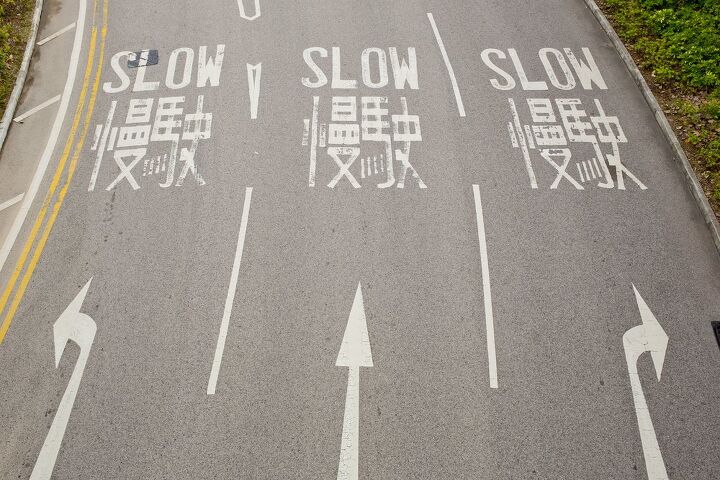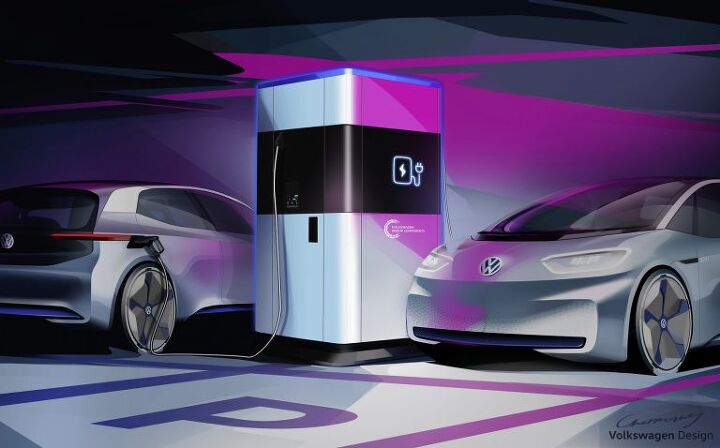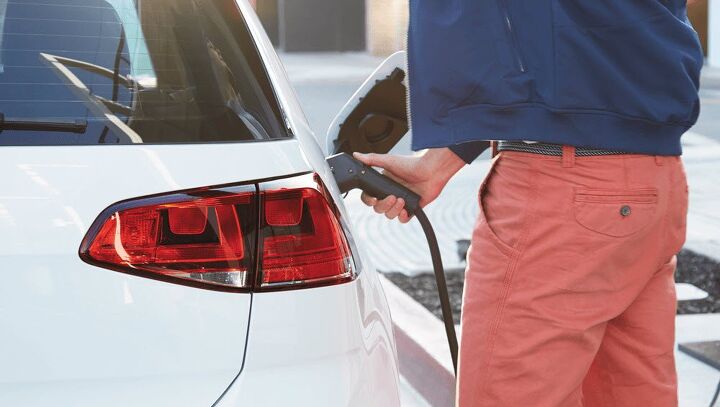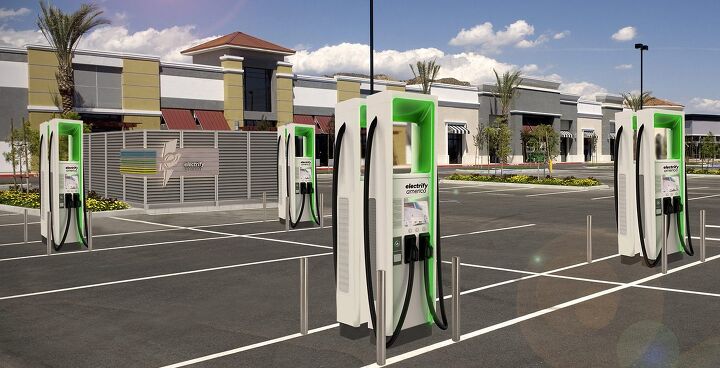#infrastructure
Fueling Stations Reach Parity in UK As Subsidy Cut Sinks Plug-in Hybrids
The United Kingdom, a highly populous (and heavily taxed) country that’s smaller than 11 U.S. states, may serve as a canary in the coal mine for electric vehicle adoption. If there’s enough places to charge up your EV, will buyers make the switch?
From across the pond comes news that, for the first time, the number of public electric vehicle charging stations has surpassed that of gasoline and diesel stations. It’s been a long road, as “normal” stations have been on a steady decline since 1970. EV stations popped up in earnest earlier this decade, fueled by government investments and green group initiatives, as well as efforts by automakers eager to provide fuel sources for their new vehicles.
Battery-electric vehicle market share in the UK in July? 1.4 percent.
VW's Electrify America Sticks With Walmart for EV Charging Expansion
Roughly a year ago, Volkswagen subsidiary Electrify America announced a partnership with Walmart to help proliferate EV charging sites across the United States. Equal parts penance for VW’s illegal diesel shenanigans and shrewd business arrangement, the deal sought to establish plug-in points at 100 store locations in 34 states.
On Thursday, the companies announced the completion of 120 charging stations and signalled their intent to continue collaborating — citing future development programs in the District of Columbia and 46 U.S. states.
Driving Dystopias: China Doesn't Sound Terribly Fun
With China having become the world’s largest automotive market by individual sales, it’s worth keeping tabs on it for burgeoning driving trends. While that’s predominantly revolved around electric vehicles, the People’s Republic also has pretty strict driving rules backed by some of the tightest monitoring of a civilian population imaginable. China is setting up a vast surveillance system that tracks every single one of its 1.4 billion citizens and is adapting it for use in its new “social credit system,” which sounds like the most Orwellian thing in existence.
The system is intended to publicly shame criminals, debtors, jaywalkers, and those with “controversial” political views while monitoring their every move but it’s also doing a fine job of making life harder for drivers.
Illinois EV Owners Face Steep New Fee, Rage Against the Machine
Like most states, Illinois hasn’t raised its gas tax in years, keeping it at 19 cents since the musically gifted year of 1990, and, like most states, Illinois needs cash for pressing infrastructure repairs. Illinois’ state gas tax joins a slew of other taxes, including income tax, that’s bundled into local pump prices, but one type of driver was able laugh at all the chumps lining up for dino juice.
The electric vehicle driver.
By virtue of their emissions-free powerplant, EV drivers side-step this area of taxation. Unfortunately for the Tesla owners of Cook County and other jurisdictions, those days may soon come to an end. A proposed law would see EV owners dinged $1,000 a year — their contribution to maintaining the roads and bridges their hefty EVs ply on a daily basis. As you’d expect, many are not happy.
Neither are conventional vehicle owners, however, as the proposal would more than double the state’s gas tax.
As It Sheds Employees, Tesla Promises a Faster Charge
Tesla, the upstart electric automaker who reminds your author of that person you knew in high school who existed in a perpetual cloud of drama, wants Tesla owners to juice up their cars in a hurry. Recharging times are one factor behind the slow adoption of EVs in North America (cost, range, and recharging availability being the others), so the automaker plans to ensure their time at the Supercharger station doesn’t go overlong.
Expect 75 miles in 5 minutes, Tesla claims.
California Congestion Bill Could Result in American Autobahn
While California has some of the best driving roads in the country, large swaths of the state suffer from serious congestion issues. For years, the preferred solution was to bolster public transit in San Francisco and Los Angeles while simultaneously establishing high-speed rail lines between the two areas. Unfortunately, costs ballooned and support for the project dwindled.
Legislators are now left with a problem. Abandoning the rail program means settling for partially completed lines incapable of transporting passengers directly between LA and the Bay Area. California needs a different solution, and Sen. John Moorlach (R-CA) has a doozy of a proposition: highway lanes with no speed limit.
Effectively, an American Autobahn.
Volkswagen's Solution to EV Charging Woes: A Charging Station That Requires Recharging
Concerned that customers won’t buy vehicles from its upcoming electric product tsunami for fear of missing their turn at the plug, Volkswagen is offering a fairly novel solution: mobile charging stations that also require recharging, presumably from a much larger charging station. A power station, for example.
The takeaway from Volkswagen’s lesson in energy packaging is “Buy an electric Volkswagen. You’ll be fine.”
VW's Electrify America Plots Second Batch of EV Charging Stations, Plug-in Propaganda
Volkswagen’s court-mandated subsidiary, Electrify America, has announced its second investment of $200 million into the nation’s electric vehicle charging infrastructure, and not a moment too soon. Plug-in car sales in the United States have already surpassed last year’s record of nearly 200,000 deliveries, thanks to Tesla’s rollout of the Model 3, and we’ve still got three months left to go.
Of course, it wouldn’t really matter if EV sales tanked in 2018 because VW is legally obliged to do this. There could have been a single, lonesome plug-in sale this year and Electrify America would still have to spend the same amount — as per its parent company’s agreement with the U.S. government. This time around, the goal is to improve charging infrastructure between cities while not ignoring major metropolitan areas. Cycle 2 will also focus primarily on California for the next 30 months, which is probably for the best. The state accounts for over half the country’s yearly EV sales.
Auto Coalition Joins Forces With NATCO to Rethink City Streets, Share Driving Data
The National Association of City Transportation Officials (NATCO) has joined Ford, Uber and Lyft to work with the data platform SharedStreets to glean a better understanding of America’s infrastructure. Their collective goal is to “make it easier for the private sector to work with cities around the world and leverage data to improve urban mobility.”
That means different things to different companies. For Uber and Lyft, aggregate data on passenger pickups and drop-offs could be useful in deciding where to deploy their vehicles. The information could also prove helpful in telling city planners how to best manage traffic patterns. Uber also said it would track speeders and what on types of roads people are more apt to drive dangerously.
It's Frustrating Times for Owners of Hydrogen-powered Cars
They’re the rarest breed on the road, drawing their car’s fuel source from the world’s most plentiful element — which just happens to be the hardest to get your hands on in any large quantity. Fuel cell vehicle drivers, of which none exist outside of California, depend on a small network of H2 refueling stations to stay on the road, and the drawbacks to using this rare power source are already well documented.
You’ll be renting a car if your road trip takes you too far from San Francisco or the SoCal area. Supply issues sometimes leaves that one nearby station out of service, as happened earlier this year. It’s almost as if a vehicle you plug into a wall is a better green idea, at least on the downstream side.
Regardless, these Honda Clarity FC, Toyota Mirai, and Hyundai Tucson FC owners made their bed and were prepared to lie in it. Unfortunately for them, the refueling network has once again revealed its fragility.
Electric Vehicles Could Short Governments $92 Billion in Taxes by 2030
As governments across the globe push for the proliferation of electric vehicles, they’re creating a new problem for themselves. While EVs may be helpful in mitigating pollution in and around city centers, they’re not going to be nearly as friendly on the infrastructure.
A report from the International Energy Agency suggests the ramp-up of battery powered automobiles could result in a $92 billion tax shortfall by 2030, assuming everything goes according to plan. But even if global governments only manage to get halfway to their intended electrification goals, they’re still missing out on an estimated $47 billion in fuel duties.
Ford's Plan to Buy Towering Detroit Pigeon Coop Isn't BS
There’s been much made about Ford’s secret/not-so-secret plan to purchase a major chunk of Detroit’s Corktown neighborhood, including its greatest landmark — the monstrous, long-abandoned Michigan Central Station. Until now, however, the only words we had to go on were whispered by sources who preferred to keep their names out of the media.
Thankfully, Edsel B. Ford II decided to pipe up today.
VW to Continue 'Electrifying America' With Help From Walmart
Volkswagen’s ongoing penance for its diesel-emission scandal includes a serious investment in to the United States’ EV charging infrastructure. But critics of the plan have previously suggested it might be a way for VW to capitalize on its corporate wrongdoing. The state of California wanted the German company to focus on disadvantaged communities while automakers worried VW might gain an early advantage in a competitive new market, especially if it could handpick the sites or partner with businesses.
It has been almost 10 months since those concerns were voiced and now Electrify America (a subsidiary of Volkswagen Group) has announced it will be partnering with Walmart to install electric charging stations at 100 stores in 34 states across America. That way you can help save the environment while you’re stocking up on plastic cups and single-serve coffee pods that will end up being dumped into the ocean.
Marching to the Beat of a Different Hum: 'Singing' Highway Turns Into 'Psychological Torture' for Residents
We’ve all been annoyed by an “earworm” in our lives — a catchy song that, even if you don’t like it, refuses to vacate your mind. Starship’s egregious, overplayed sell-out hit “We Built This City” falls firmly in this category. Grace Slick should be ashamed.
For residents living off the N357 highway near the Dutch town of Jelsum, however, this constantly repeating tune was the anthem of the Friesland region — but it wasn’t just in their heads. Blame motorists, a well-meaning but short-sighted local government, and patriotism.
White House At Least Considering Increasing Gas Tax, Needs to Consult Congress
The United States’ 18.4-cent-per-gallon tax on gasoline and 24.4-cent tax on diesel hasn’t changed since 1993. Despite this, the opinion that it should be hiked as a way of funding public works was nowhere near the White House’s official infrastructure strategy. But Donald Trump isn’t averse to the idea. In fact, he proposed a 25-cent increase to senators during a Wednesday meeting as a possible funding solution.
White House officials claim the president says “everything is on the table” in terms of finding a solution for America’s growing infrastructure problems. But how serious the rest of the Trump administration is about raising the fuel tax is debatable.






























Recent Comments